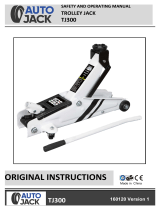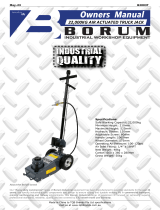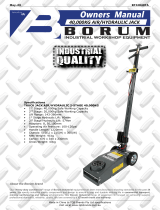Sealey 3003CXQ is a reliable 3-tonne trolley jack, perfect for lifting vehicles for repairs or tire changes. Its sturdy construction and single-piece hydraulic unit ensure stability, while the integral saddle pad protects the jacking point. The "Rocket Lift" feature allows for quick and easy lifting, and the safety overload valve prevents the jack from exceeding its capacity. For safety, always use axle stands to support the vehicle before working underneath.
Sealey 3003CXQ is a reliable 3-tonne trolley jack, perfect for lifting vehicles for repairs or tire changes. Its sturdy construction and single-piece hydraulic unit ensure stability, while the integral saddle pad protects the jacking point. The "Rocket Lift" feature allows for quick and easy lifting, and the safety overload valve prevents the jack from exceeding its capacity. For safety, always use axle stands to support the vehicle before working underneath.


-
 1
1
-
 2
2
Sealey 3003CXQ is a reliable 3-tonne trolley jack, perfect for lifting vehicles for repairs or tire changes. Its sturdy construction and single-piece hydraulic unit ensure stability, while the integral saddle pad protects the jacking point. The "Rocket Lift" feature allows for quick and easy lifting, and the safety overload valve prevents the jack from exceeding its capacity. For safety, always use axle stands to support the vehicle before working underneath.
Ask a question and I''ll find the answer in the document
Finding information in a document is now easier with AI
Related papers
-
Sealey 2201HL Operating instructions
-
Sealey 1030CXDK Operating instructions
-
Sealey 10QJ.V5 Operating instructions
-
Sealey RJA1550.V2 User manual
-
Sealey 3040A.V2 Series Operating instructions
-
Sealey PBJ12S User manual
-
Sealey 4040A Series Trolley Jack 4 Tonne Low Profile Rocket Lift Green User manual
-
Sealey 3200LEHL User manual
-
Sealey 4040A.V3 Series User manual
-
Sealey 4040A.V2 Series Operating instructions
Other documents
-
 Autojack TJ300 Owner's manual
Autojack TJ300 Owner's manual
-
Certa CTTJCK2000A User guide
-
Clarke CTJ2500QLGB TONNE 2.5 TROLLEY JACK User manual
-
Draper Transmission Jack Operating instructions
-
Allstar ALL10425 Owner's manual
-
Clarke CTJ3000GB User manual
-
 Borum Industrial B2003T Owner's manual
Borum Industrial B2003T Owner's manual
-
 Borum Industrial BTJ2040TA Owner's manual
Borum Industrial BTJ2040TA Owner's manual
-
SIP 03627 User manual
-
Clarke CTJ3000QLB Garage Jack User manual




